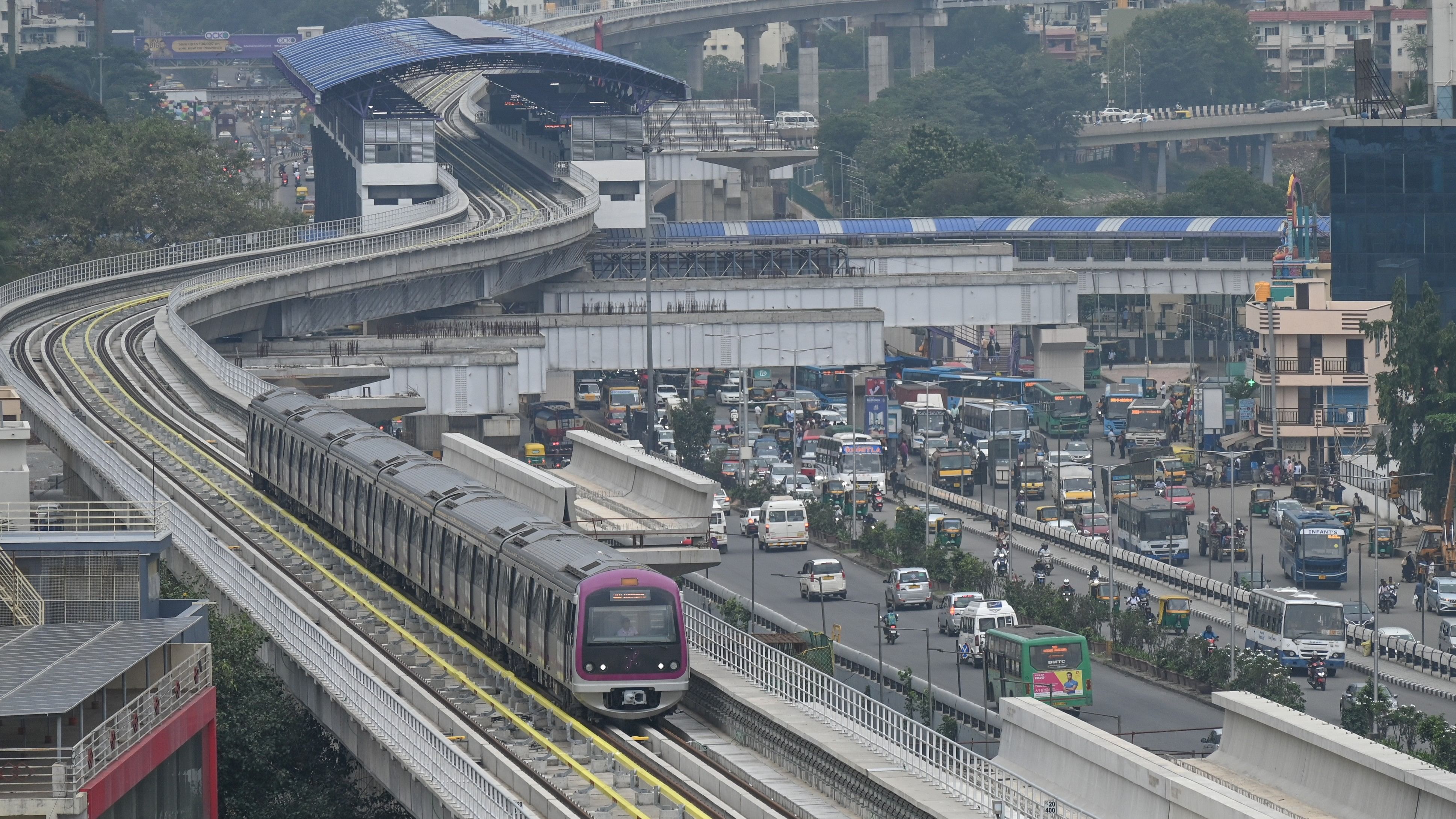
A metro train leaves the Tin Factory (Benniganahalli) station on Monday after the Purple Line became fully operational.
Credit: DH Photo/S K Dinesh
The first weekday brought jubilation and fewer traffic snarls to a city known as the world’s second-most congested.
Bengalureans rejoiced at the opening of two small metro sections on Monday. The years-long wait seemed to have been worth it. Of the two, the 2.1-km-long Baiyappanahalli-KR Pura section is critical because it connects the tech hub of Whitefield to the rest of the city.
Namma Metro reported a decent uptick in its ridership with trains ferrying 5.86 lakh passengers between 5 am and 8 pm. The numbers will rise further as metro trains run until nearly midnight. For context, the metro’s average daily ridership is 6.5 lakh.
With the Purple Line fully operational now, Bangalore Metro Rail Corporation Limited (BMRCL) expects to ferry 7.5 lakh passengers per day.
Metro operations had a positive impact on the traffic situation, too. Traffic police reported a drastic reduction in congestion during the morning rush hours, especially between Tin Factory (Benniganahalli) and Whitefield, at Hoodi Junction and outside the Baiyappanahalli metro station.
The Tin Factory-Whitefield section, which saw 226 congestion alerts spanning 44,000 metres on September 25 (Monday), reported half the numbers with only 113 congestion alerts spanning 22,000 metres.
The Tin Factory-KR Pura section reported only 26 congestion alerts spanning 5,000 metres. The numbers for September 25 were 51 and 11,000, respectively.
Hoodi Jn saw only five congestion alerts spanning 908 metres, as against 10 congestion alerts spanning 1,815 metres on September 25.
“Parking and pedestrian movement was significantly reduced at the Baiyappanahalli metro station, too, aiding traffic flow,” M N Anucheth, Joint Commissioner of Police (Traffic), told DH.
Previously, people had to park or exit the metro station and take the feeder buses towards KR Pura and proceed towards Whitefield. The opening of the missing link negates the need for the switch at the station, reducing traffic on the road instantly.
Traffic flow from MM Temple towards Mahadevapura via the KR Puram railway station under the hanging bridge also improved due to fewer vehicles on the road. Vehicle queue length at traffic signals on the same road fell from 150 metres to about 100 metres, a reduction of at least 33%, as of 10 am, he explained.
Anucheth, however, cautioned that a better understanding of the impact of the full metro line can be gauged only after a week’s worth of data. “As more people become aware that the Purple Line is fully operational, they might switch to the metro. That will further bring down the traffic. We need to observe for a week for detailed analysis and trends,” he said.
The news of reduced congestion comes barely two weeks after Bengaluru’s Outer Ring Road (ORR) witnessed one of the worst traffic jams in recent memory.
Enhanced metro connectivity will likely ease vehicular congestion along the ORR because KR Pura and the new Benniganahalli (Tin Factory) station serve as important junctions along the route.
M V Rajeev Gowda, deputy chairperson of the State Institute for the Transformation of Karnataka (SITK), said that the government was keen on improving the metro feeder bus service.
“We now have at least 20 BMTC buses from the KR Pura metro station to Silk Board Jn along the ORR. We are planning to formally launch this on Wednesday. There are also plans to launch KR Pura-Whitefield loop feeder buses on the same day,” he said.